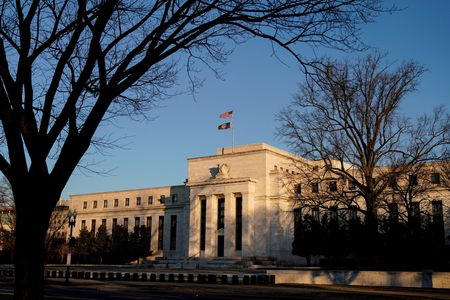By Michael S. Derby
NEW YORK (Reuters) – A Federal Reserve tool that provides liquidity in times of stress could be strengthened if it were open to more participants and integrated into how regulators assessed financial market firms’ liquidity positions, participants at a New York Fed event said on Wednesday.
Speaking at a conference on Treasury market issues, the panelists – Harvard University’s Jeremy Stein, Yale University’s Andrew Metrick and Goldman Sachs executive Beth Hammack – were taking stock of a central bank facility launched last summer.
The Fed’s Standing Repo Facility allows eligible firms, who are mainly large banks, to quickly convert their Treasuries into short-term cash loans. The facility was designed to provide a safety valve for times where liquidity runs short in bond markets.
Since its launch, the tool has gone essentially unused and has not been tested in crises. But many experts and market participants say its existence should help if trouble arrives.
They reckon it would save the Fed from having to intervene in financial markets, as it did in the closing months of 2019 when bank reserves ran low and the spring of 2020 when markets seized up at the start of the coronavirus pandemic.
Focus has gravitated to the Standing Repo Facility given the market fragility as major central banks around the world have pursued aggressive rate increases to lower the highest levels of inflation in four decades. That has stressed liquidity in markets, most notably in the U.S. Treasury bond market, which serves as the backbone of the world’s credit system.
Liquidity stresses have raised fears of broader dysfunction, especially should some sort of shock develop. But observers believe the Treasury market might be okay in the face of the trouble in part because the Standing Repo Facility will help ensure liquidity is there for those who need it.
But that does not mean the facility cannot be strengthened. Stein, who was once a Fed governor, called the repo facility a “good thing” but thinks it was a missed opportunity to not make it more broad based and open to more potential participants.
More participants might reduce the chance the Fed will have to intervene. One reason why many in markets worry about Fed interventions is the Bank of England’s recent experience. There, the central bank was forced to buy bonds to stem a market crisis and that action muddled the BoE’s broader effort to withdraw stimulus from the market.
Meanwhile, Hammack said one other way the Standing Repo Facility could be made strong is for bank regulators to take it on board when assessing financial firms’ overall liquidity positions.
(Reporting by Michael S. Derby; Editing by Josie Kao)

